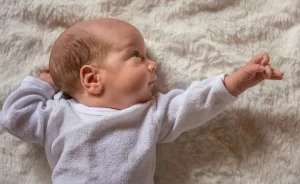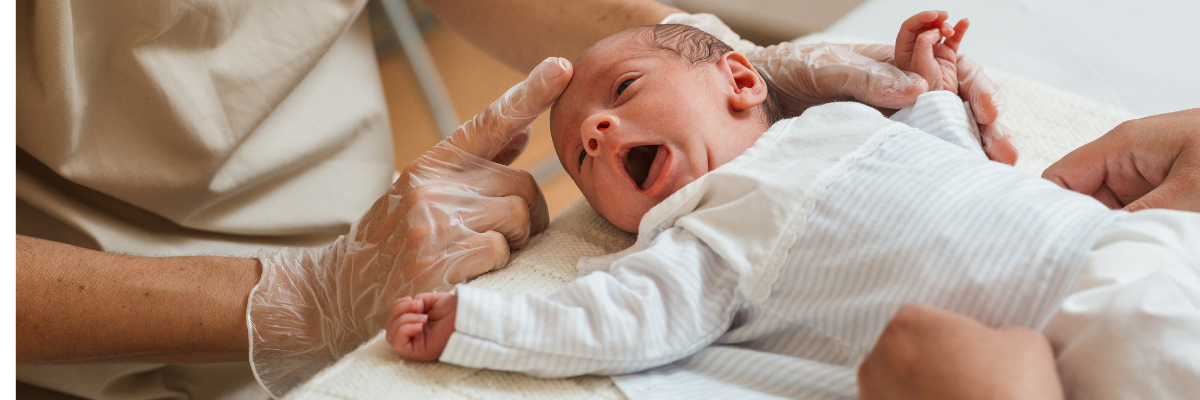A reflex is an automatic and instantaneous response to a sensory stimulus. Remember when you were a child at the doctor’s office and they tapped your knee with a small mallet to check if your leg kicked upwards? You didn’t decide to kick your leg, it just kicked. From infancy, reflexes are vitally important for proper development of the brain, nervous system, body and sensory systems. Some reflexes are meant to stay with us our whole lives. Others are designed to be dormant after their function is fulfilled – also called integration. Check out this awesome resource from Tools to Grow to learn more about specific reflexes and how they impact a child’s function during their daily life. Primitive reflexes are adaptive responses that develop before birth and typically integrate as the brain matures. Primitive reflexes are important for survival and development early in life; however, it is also important that they become integrated as the child grows. Retained reflexes can cause sensory issues, postural disorders, decreased motor skills, and attention/behavioral issues.
What causes retention of primitive reflexes?
Some potential causes of retention of primitive reflexes include c-sections, trauma during birth, exposure to toxins, decreased tummy time during infancy, decreased time crawling, chronic ear infections, or head injuries during infancy among many other unknown causes.
Five Commonly Retained Primitive Reflexes and their Impact on Occupations
1. Moro Reflex
The Moro Reflex is known as the “startle” reflex. This reflects is a fight or flight reaction. It is present at birth and should be integrated by four months. Common effects of retention include emotional outburst, motion sickness, and difficulties with vision, reading, and writing.
2. Asymmetric Tonic Neck Reflex (ATNR)

The Asymmetric Tonic Neck Reflex (ATNR) is known as the “Fencer’s pose”. It assists in the birthing process. It appears at birth and should be integrated by nine months. Common effects of retention include decreased eye-hand coordination, poor handwriting, poor balance, difficulty with reading and math, and difficulty focusing.
3. Symmetric Tonic Neck Reflex (STNR)
The Symmetric Tonic Neck Reflex (STNR) is an essential foundation for crawling. It appears at six to eight months and should be integrated by nine to eleven months. Common effects of retention include poor posture, W sitting position, poor eye-hand coordination, messy eater, and low muscle tone.
4. Tonic Labyrinthine Reflex (TLR)
The Tonic Labyrinthine Reflex (TLR) is commonly seen in children with ADHD diagnoses. It appears before birth and should be integrated by three and a half years of age. Common effects of retention include decreased balance, poor spatial awareness, toe walking, weak muscles, poor posture, and difficulty with climbing.
5. Spinal Galant
The Spinal Galant Reflex also assists in the birthing process. It appears at birth and should be integrated by three to nine months. Common effects of retention include bed wetting after potty training, hyperactivity, postural issues including scoliosis, attention issues, and decreased endurance.
What are integrated reflexes?
Integrated reflexes are important for developing motor control. A child needs motor control to maintain proper posture at a desk in school, ride a bike, read a book, cross midline, write, and get dressed. A child with integrated reflexes has normal movement patterns to complete these functional tasks at home and at school. A child with unintegrated reflexes could benefit from skilled reflex integration therapy which will essentially train a child’s brain by establishing an efficient movement pattern that supports higher level motor skills or cognitive tasks.
How do you know whether or not your child has integrated these reflexes?
There are many common areas of difficulty that may suggest a retained reflex including the following:
- “Bouncing” Child: Constantly moving, can’t sit still on a chair, hyperactive
- “Noodle” Child: Leans on everything, rests head on table
- “Shirt Chewers”: Constantly chewing on shirts or pencils, and touches everything
- “Emotional Child”: Challenges with regulating emotions, easily frustrated or upset, difficulty with utilizing age appropriate coping strategies to calm body
- School Performance Challenges: difficulty with reading, handwriting, language/speech, poor sitting balance and immature grasp on writing utensils
- Coordination Challenges: Chronic body aches, poor endurance, fatigue, muscle weakness, poor concentration, fidgeting, disorganization
How do I know If My Child Has Retained Primitive Reflexes and What Can I Do?
Once your Occupational Therapist suspects a retained reflex, he/she will educate the caregiver on the importance of carryover for treatment recommendations. Caregivers play an important role in seeing progression in their child’s everyday activities. It is typically recommended that the child completes a set of tailored exercises to meet your child’s needs, 5-10 minutes per day, for 30 consecutive days in order to see any progress. Your therapist may recommended a reward or sticker chart in order to keep your child motivated towards an end goal. Progress can be noted short term and over 9-12 months. In addition to exercises, your Occupational Therapist will make recommendations for modifications in the school and home environments which may include changing positioning during school work, movement breaks, sensory techniques, relaxation techniques, decreasing auditory and visual stimulation, and organizational skills, just to name a few!
In order to determine whether your child would benefit from direct treatment for Reflex Integration, it is recommended that your child be evaluated or screened by an Occupational Therapist at Carolina Therapy Connection. Give us a call at 252-341-9944 today to schedule your FREE occupational therapy screening with one of our experienced and knowledgable OT’s.

